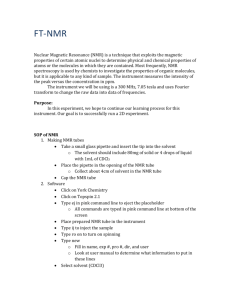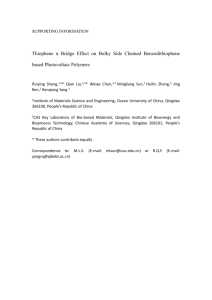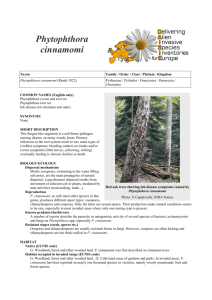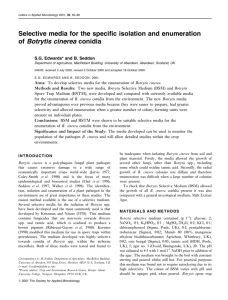(Fabaceae) against Botrytis cinerea and Phytophthora
advertisement
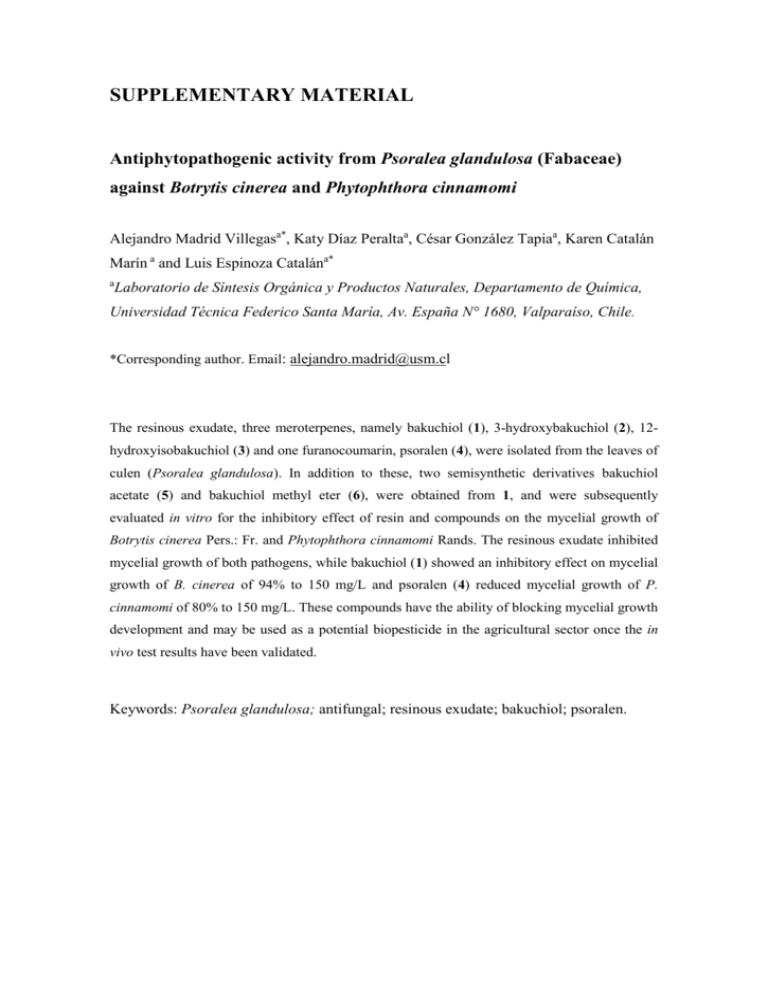
SUPPLEMENTARY MATERIAL Antiphytopathogenic activity from Psoralea glandulosa (Fabaceae) against Botrytis cinerea and Phytophthora cinnamomi Alejandro Madrid Villegasa*, Katy Díaz Peraltaa, César González Tapiaa, Karen Catalán Marín a and Luis Espinoza Catalána* a Laboratorio de Síntesis Orgánica y Productos Naturales, Departamento de Química, Universidad Técnica Federico Santa María, Av. España N° 1680, Valparaíso, Chile. *Corresponding author. Email: alejandro.madrid@usm.cl The resinous exudate, three meroterpenes, namely bakuchiol (1), 3-hydroxybakuchiol (2), 12hydroxyisobakuchiol (3) and one furanocoumarin, psoralen (4), were isolated from the leaves of culen (Psoralea glandulosa). In addition to these, two semisynthetic derivatives bakuchiol acetate (5) and bakuchiol methyl eter (6), were obtained from 1, and were subsequently evaluated in vitro for the inhibitory effect of resin and compounds on the mycelial growth of Botrytis cinerea Pers.: Fr. and Phytophthora cinnamomi Rands. The resinous exudate inhibited mycelial growth of both pathogens, while bakuchiol (1) showed an inhibitory effect on mycelial growth of B. cinerea of 94% to 150 mg/L and psoralen (4) reduced mycelial growth of P. cinnamomi of 80% to 150 mg/L. These compounds have the ability of blocking mycelial growth development and may be used as a potential biopesticide in the agricultural sector once the in vivo test results have been validated. Keywords: Psoralea glandulosa; antifungal; resinous exudate; bakuchiol; psoralen. Experimental General procedure Unless otherwise stated, all chemical reagents purchased (Merck, Darmstadt, Germany or Aldrich, St. Louis, MO, USA) were of the highest commercially available purity and were used without previous purification. IR spectra were recorded as thin films in a FTIR Nicolet 6700 spectrometer (Thermo Scientific, San Jose, CA, USA) and frequencies are reported in cm−1. Low resolution mass spectra were recorded on an Agilent 5973 spectrometer (Agilent Technologies, Santa Clara, CA, USA) at 70eV ionising voltage in a DB-5 m, 30 m × 0.25 mm × 0.25 µm column, and data are given as m/z (%rel. int.). 1 H and 13C spectra were recorded on a Bruker Avance 400 Digital NMR spectrometer (Bruker, Rheinstetten, Germany), operating at 400.1 MHz for 1H and 100.6 MHz for 13 C. Chemical shifts are reported in δ ppm and coupling constants (J) are given in Hz. Silica gel (Merck 200–300 mesh) was used for C.C. and silica gel plates HF 254 for TLC. TLC spots were detected by heating after spraying with 25% H2SO4 in H2O. Plant material Leaves of P. glandulosa were collected in Lo Orozco, Gran Valparaíso province, in January of 2013. Forest Engineer Patricio Novoa identified the plant and a voucher specimen (No. Pg-01113) was deposited at the Herbarium of the Natural Products Laboratory, ‘‘Dr. Herbert Appel A’’, Department of Chemistry, UTFSM, Valparaíso, Chile. Extraction, isolation, synthesis and structural elucidation Extraction of the resinous exudate and isolation of compounds 1-3 Aerial parts of fresh P. glandulosa (1 kg) were immersed in dichloromethane (1 L) for 30 s at room temperature, and the filtered solution was then concentrated under reduced pressure to give the resin extract (30 g). (Madrid et al. 2013). The resinous exudate (4 g) was fractionated by column chromatography (CC) (silica gel) using a hexane-ethyl acetate of increasing polarity, obtained bakuchiol (1) (2.623 g) and impure fractions. Further purification of impure fractions was achieved using a CC and preparative chromatography (silica gel Merck plates HF-254). The isolated compounds were as follows: 3-hydroxy-bakuchiol (2) (289.63 mg), 12-hydroxyisobakuchiol (3) (30.2 mg). Preparation of the dichloromethane extract and isolation of compound 4 Leaves of P. glandulosa without resinous exudates were macerated in dichloromethane at room temperature for 72 h. The solution was filtered and concentrated under reduced pressure on a rotatory evaporator at 40 °C, and 55.6 g of the crude dichloromethane extract were obtained. The pure compound 4 was isolated according to protocol of Erazo et al., 1990. The extract (2 g) was chromatographed by CC (silica gel) using a hexane-ethyl acetate of increasing polarity, afforded bakuchiol (1) (0.963 g) and psoralen (4) (0.125 g). Structural elucidation of natural compounds Compounds 1-4 were identified by melting point and spectroscopic data, including 1H and 13C NMR, and were either compared with authentic samples obtained previously in our laboratory (Madrid et al. 2012) for bakuchiol (1) and 3-hydroxy-bakuchiol (2) or with literature data for 12-hydroxyisobakuchiol (3) (Labbe´ et al., 1996) and psoralen (4) (Liu et al. 2005). Bakuchiol (1): slightly yellow oil. 1H NMR (CDCl3, 400 MHz) δ H: 7.22 (2H, d, J=7.2 Hz, H-2 and H-6); 6.73 (2H, d, J=7.2 Hz, H-3 and H-5); 6.23(1H, d, J=16.2 Hz, H-7); 6.03 (1H, d, J=16.3 Hz, H-8); 5.86 (1H, dd, J=10.9 and 17.3 Hz, H-17); 5.11 (1H, t, J=7.0, H-12); 5.03 (2H, m, H-18); 1.96 (2H, m, H-11); 1.67 (3H, s, H-14); 1.58 (3H, s, H-5); 1.48 (2H, m, H-10); 1.19 (3H, s, H-16). 13C NMR (CDCl3, 100 MHz) δ C: 154.6 (C-4), 145.9 (C-17), 135.4 (C-8), 131.3 (C-1), 130.5 (C-13), 127.3 (C-2 and C-6), 126.8(C-8), 124.8 (C-12), 115.3 (C-3 and C-5), 111.9 (C-18), 42.5 (C-9), 41.3 (C-10), 25.6 (C-16), 23.3 (C-15), 23.2 (C-11), 17.6 (C-14). 3-Hydroxy-bakuchiol (2): slightly brown oil. 1H NMR (CDCl3, 400 MHz) δ H: 6.92 (1H, s, H-2); 6.79 (2H, s, H-5 and H-6); 6.19 (1H, d, J=16.2 Hz, H-7); 6.03 (1H, d, J=16.2 Hz, H-8); 5.86 (1H, dd, J=10.9 and 17.3 Hz, H-17); 5.09 (1H, t, J=6.9, H-12); 5.01 (2H, m, H-18); 1.94 (2H, m, H-11); 1.67 (3H, s, H-14); 1.58 (3H, s, H-15); 1.47 (2H, m, H-10); 1.18 (3H, s, H-16). 13C NMR (CDCl3, 100 MHz) δ C: 145.9 (C-4), 143.5 (C-3), 142.6 (C-17), 136.2 (C-8), 131.7 (C-1), 130.5 (C-13), 126.4 (C-7), 124.8 (C-12), 119.4 (C-6), 115.4 (C-5), 112.7 (C-2), 111.9 (C-18), 42.5 (C-9), 41.3 (C-10), 25.7 (C16), 23.3 (C-15), 23.2 (C-11), 17.6 (C-14). 12-Hydroxyisobakuchiol (3): brown oil. 1H NMR (CDCl3, 400 MHz) δ H: 7.22 (2H, d, J=8.5 Hz, H-2 and H-6); 6.75 (2H, d, J=8.5 Hz, H-3 and H-5); 6.23(1H, d, J=16.3 Hz, H-7); 6.03 (1H, d, J=16.3 Hz, H-8); 5.86 (1H, dd, J=10.9 and 17.3 Hz, H17); 5.34 (1H, bs, OH); 5.03 (2H, m, H-18); 4.97 (2H, m, H-15); 4.05 (1H, bt, H-12); 1.74 (3H, s, H-14); 1.54 (2H, m, H-11), 1.28 (2H, m, H-10), 1.18 (3H, s, H-16). 13C NMR (CDCl3, 100 MHz) δ C: 154.4 (C-4), 147.1 (C-17), 145.7 (C-13), 135.4 (C-8), 130.5 (C-1), 127.3 (C-2 and C-6), 126.8(C-7), 115.4 (C-3 and C-5), 112.2 (C-18), 111.5 (C-14), 76.6 (C-12), 42.1 (C-9), 36.8 (C-11), 29.6 (C-10), 23.4 (C-16), 17.4 (C-15). Psoralen (4): colorless needles. mp: 162-163°C. 1H NMR (CDCl3, 400 MHz) δ H: 7.79 (1H, d, J=9.6 Hz, H-4), 7.67 (1H, d, J=2.4 Hz, H-12), 7.66 (1H, s, H-5), 7.46 (1H, s, H-8), 6.81 (1H, d, J=2.4 Hz, H-11), 6.37 (1H, d, J= 9.6 Hz, H-3). 13C NMR (CDCl3, 100 MHz) δ C: 161.1 (C-2), 156.4 (C-7), 152.0 (C-9), 146.9 (C-12), 144.1 (C4), 124.9 (C-6), 119.8 (C-5), 115.4 (C-10), 114.6 (C-3), 106.4 (C-11), 99.9 (C-8). General procedure for synthesis of 5 and 6 Compound 5 was prepared from a solution of bakuchiol (1.0 g, 4 mmol) in dichloromethane (25 mL) and acetylated by the conventional method, using the acetic anhydride/pyridine system and 4-dimethylaminopyridine, to yield bakuchiol acetate (5) (1.17 g, 98,6 %). In a separate batch, a solution of bakuchiol (1.0 g, 4 mmol) in dichloromethane (25 mL) was added to a solution of diazomethane in diethyl ether (3.0 mL) and the contents were stirred for 2 h at room temperature. The reaction mixture was diluted with ice-cold water and extracted with ethyl acetate (2x50 mL). The organic layer was dried, concentrated, and purified by column chromatography over silica gel (60-120 mesh) with hexane-ethyl acetate as the eluent to give bakuchiol methyl eter (6) (0.974 g, 90.2%). Structural elucidation of semisynthetic compounds The spectroscopic properties of 1H and 13C NMR for compounds 5 and 6 were consistent with those previously reported (Chen et al., 2008; Reddy et al., 2010). Bakuchiol acetate (5): slightly yellow oil. 1H NMR (CDCl3, 400 MHz) δ H: 7.35 (2H, d, J=7.2 Hz, H-2 and H-6), 7.01 (2H, d, J=7.2 Hz, H-3 and H-5), 6.23 (1H, d, J=16.2 Hz, H-7), 6.15 (1H, d, J=16.3 Hz, H-8), 5.87 (1H, dd, J=10.9 and 17.3 Hz, H17), 5.11 (1H, t, J=7.0, H-12), 5.05 (2H, m, H-18), 2.26 (3H, s, CH3CO), 1.96 (2H, m, H-11), 1.67 (3H, s, H-14), 1.58 (3H, s, H-5), 1.48 (2H, m, H-10), 1.19 (3H, s, H-16). 13 C NMR (CDCl3, 100 MHz) δ C: 169.3 (CH3CO), 149.4 (C-4), 145.9 (C-17), 138.1 (C-8), 135.6 (C-1), 131.2 (C-13), 126.9 (C-2 and C-6), 126.2 (C-7), 124.6 (C-12), 121.4 (C-3 and C-5), 112.0 (C-18), 42.5 (C-9), 41.1 (C-10), 25.6 (C-16), 23.2 (C-15), 23.1 (C11), 21.0 (CH3), 17.6 (C-14). Bakuchiol methyl eter (6): slightly yellow oil. 1H NMR (CDCl3, 400 MHz) δ H: 7.29 (2H, d, J=8.6 Hz, H-2 and H-6), 6.84 (2H, d, J=8.6 Hz, H-3 and H-5), 6.26 (1H, d, J=16.3 Hz, H-7), 6.15 (1H, d, J=16.3 Hz, H-8), 5.87 (1H, dd, J=10.9 and 17.3 Hz, H17), 5.11 (1H, t, J=7.0, H-12), 5.03 (2H, m, H-18), 3.80 (3H, s, CH3O), 1.96 (2H, m, H11), 1.67 (3H, s, H-14), 1.57 (3H, s, H-5), 1.48 (2H, m, H-10), 1.20 (3H, s, H-16). 13C NMR (CDCl3, 100 MHz) δ C: 158.8 (C-4), 146.1 (C-17), 138.0 (C-8), 135.4 (C-1), 131.0 (C-13), 127.0 (C-2 and C-6), 126.6 (C-8), 124.7 (C-12), 114.3 (C-3 and C-5), 111.4 (C-18), 55.3 (OCH3), 42.5 (C-9), 41.3 (C-10), 25.6 (C-16), 23.3 (C-15), 23.2 (C11), 17.6 (C-14). Fungal Isolate and Culture Condition In this study, the strains UK-1 and PC-1 of Botrytis cinerea and Phythophthora cinnamomi Rands, respectively were used in all experiments. These strains were isolated from a naturally infected grape (Vitis vinifera) and avocado (Persea americana), and were maintained on a potato dextrose agar medium (PDA; Difco, Detroit, MI, USA) at 4 °C. The inoculum of these pathogens were grown on PDA in photoperiod of 16 h light/8 h dark at 23 °C for 5 and 8 days, for B. cinerea and P. cinnamomi, respectively. Antifungal Activity against B. cinerea and P. cinnamomi The antifungal activity of the resinous exudates, compounds 1-6, negative control, the positive control (commercial fungicide captan® and metalaxil® for B. cinerea and P. cinnamomi, respectively) was assessed using the agar-diffusion assay technique for the on PDA medium (Mendoza et al., 2009). The resinous exudate and the compounds were each dissolved in 1% aqueous solution of ethanol in water to different final concentrations. Negative and positive control experimental conditions for mycelia growth of B. cinerea and P. cinnamomi were included. Negative control conditions consisted of a PDA medium containing 1% ethanol, whereas the positive controls included PDA media with commercial fungicides captan® and metalaxil®, each at the same concentration specified for the compounds of interest. A plug (4 mm) of PDA medium with 5-day-old mycelium colonies of the pathogen was placed at the center of a petri dish with the PDA medium with or without compounds of interest. Subsequently, they were incubated under controlled conditions at 23 °C and photoperiod 16 h light/8 h for 48 and 96 h of incubation for B. cinerea and P. cinnamomi, respectively. The percentage of inhibition of mycelial growth was based on colony diameter measurements after 48 h of incubation for B. cinerea and 96 h of incubation for P. cinnamomi. The inhibition percentages of mycelial growth were calculated for each compound and compared with the negative control (Hou et al., 2013). All treatments were performed independently three times in triplicate. Table S1. Antifungal activity of the resinous exudate, the natural and semisynthetic compounds obtained from P. glandulosa against B. cinerea and P. cinnamomi in vitro. Compound Concentration B. cinerea P. cinnamomi (mg/L) (%IMG) (%IMG) 400 85 76 150 74 65 150 94 47 100 91 43 150 75 5 100 71 16 150 52 4 100 47 13 150 41 80 100 0 58 150 57 43 100 5 32 150 38 40 100 0 35 400 100 - 150 94 - 400 - 100 150 - 100 (C−) B. cinerea 0 0 0 (C−) P. cinnamomi 0 0 0 Resinous exudate 1 2 3 4 5 6 Captan ® Metalaxil ® %IMG: The Percentage of inhibition of mycelial growth was based on colony diameter measurements after 48 h of incubation for B. cinerea and 96 h of incubation for P. cinnamomi. (C−): Negative control Figure S1. Structures of natural 1-4 and synthetic 5-6 compounds from the leaves of P. glandulosa. Figure S2. Inhibition effect of the mycelial growth of the different treatments against B. cinerea: a) Negative control (PDA without addition of compounds); b) Resinous exudate 150 mg/L and c) 400 mg/L; d) Compound 1 (Bakuchiol) 150 mg/L Figure S3. Inhibition effect of the mycelial growth of the different treatments against P. cinnamomi: a) negative control (PDA No compound addition); b) resinous exudate 150 mg/L and c) 400 mg/L; d) Compound 4 (psoralen) 150 mg/L. References Chen H, Du X, Tang W, Zhou Y, Zuo J, Feng H and Li Y. 2008. Synthesis and structure–immunosuppressive activity relationships of bakuchiol and its derivatives. Bioorg Med Chem. 16: 2403-2411. Hou Z, Yang R, Zhang C, Zhu L, Miao F, Yang X, Zhou L. 2013. 2-(Substituted phenyl)-3,4-dihydroisoquinolin-2-iums as novel antifungal lead compounds: Biological evaluation and structure-activity relationships. Molecules. 18: 1041310424. Liu Z, Zang X, Zhao S, Zhou R. 2005. Extraction and purification of psoralen from Psoralea corylifolia L. J First Mil Med Univ. 25: 751-752. Madrid AM, Espinoza LJ, Mellado MA, Osorio ME, Montenegro, IJ, Jara CE. 2012. Evaluation of the antioxidant capacity of Psoralea glandulosa L. (Fabaceae) extracts. J Chil Chem Soc. 57: 1328-1332. Madrid A, Espinoza L, Mellado M, Montenegro I, González C, Santander S, Villena J, Jara C. 2013. Study of the chemical composition of the resinous exudate isolated from Psoralea glandulosa and evaluation of the antioxidant properties of the terpenoids and the resin. Bol Latinoam Caribe Plant Med Aromat 12: 338-345. Mendoza L, Espinoza P, Urzua, A, Vivanco M, Cotoras M. 2009. In vitro antifungal activity of the diterpenoid 7á-hydroxy-8(17)-labden-15-oic acid and its derivatives against Botrytis cinerea. Molecules. 14: 1966-1979. Reddy MV, Thota N, Sangwan PL, Malhotra P, Ali F, Khan IA, Chimni SS, Koul S. 2010. Novel bisstyryl derivatives of bakuchiol: Targeting oral cavity pathogens. Eur J Med Chem. 45: 3125-3134.

